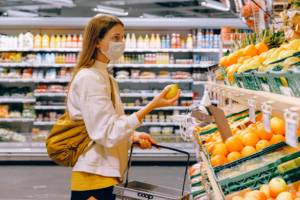Overseeing demand for retail furniture and shelving, we gain a great perspective into high street trends. Each surge and drop in popularity tells a story about retail design, whether that is the revival of greeting card displays or a growing preference for natural materials and aesthetics. Even basic nuts and bolts can be indicative of store design trends.
In 2020, we understandably saw plenty of significant changes. Brick and mortar stores adapted quickly to lockdown restrictions and, despite incredibly tough times, there was a great resilience and creativity showcased among retailers that helped many to weather the challenge. The new normal became a common term, often applied in retail to cashless transactions, increased deliveries, checkout dividers, and sanitisation booths. The shopping experience changed as stores hastily renovated their spaces to accommodate safe custom.
Now, as we begin to leave the pandemic behind, the Crown Display team are reflecting on changing demand, considering what the new normal means for the high street.

Collaborative Spaces
As retailers seek to minimise their overheads and keep strict budgets so as to make themselves robust, collaborative spaces are becoming increasingly popular. The concept is simple; two or more retailers share a single space, often working in tandem and with complementary products or services.
This idea has been around for some time and on many levels. Whether start-up businesses work together, such as a new cafe opening inside a clothing store, or established brands merge their spaces, like Argos and Sainsbury’s, there are plenty of potential benefits.
Making two concepts work well together, however, isn’t always easy, especially in a small space. We’re seeing a greater demand for modular shop shelving and custom design retail furniture as stores seek to better interlock and blend multiple retail concepts.
Local Design
During the lockdowns of 2020, there was remarkable support for communities. Not only were residents gathering together to ensure their local and favoured retailers survived but the retailers themselves endeavoured to deliver their services to the local area. Locality became so valued that smaller, independent businesses actually performed better than many national brands.
Knowing the advantage of a positive relationship with the local area gives retailers, it is likely to become more important than ever. We expect to see more regional products, local designs, and a celebration of communal identity across the high street.
This also extends to local materials and styles being used not only because they echo a brand’s aesthetic but a local one too. Shop counters made from local hardwood or slatwall panels displaying the area’s colour might be the detail some stores are looking for.
Personalised Experience
For years, personalisation has proven an effective tool for retailers, perhaps most famously demonstrated by campaigns like ‘Share a Coke’. Customers are more likely to make a purchase if the product or service is personal in some way.
Alongside technology and pandemic necessity, retailers are working to make their spaces more personal. One persistent advantage that high street retailers have over online stores is that customers continue to enjoy browsing, hoping to find new products. Building upon this, retailers are offering more personal experiences, with dedicated staff members showcasing products, as well as a key emphasis on employee-customer relationships to ensure brand loyalty.



